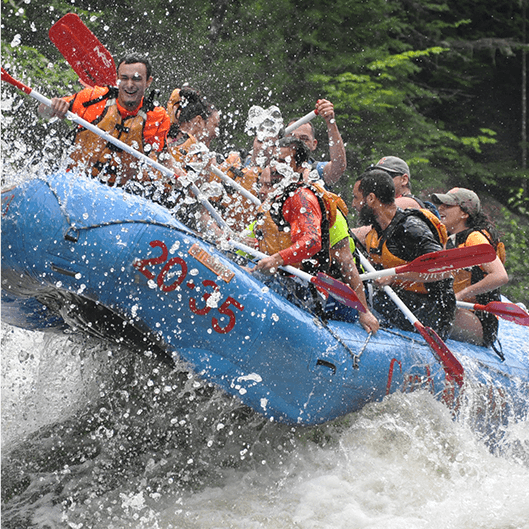Whitewater Rafting in Maine, Massachusetts and Vermont: Whitewater Rapid Classifications
Thanks to the Safety Code of American Whitewater for this outline of the International Scale of River Difficulty. Crab Apple Whitewater Rafting and many of our individual white water staff and river rafting guides are members of American Whitewater, “a national non-profit organization with a mission ‘to conserve and restore America’s whitewater resources and to enhance opportunities to enjoy them safely.’”
This article is based on the American version of the rating system used to compare river difficulty throughout the world. It has been modified to better describe white water rapid classifications in relation to whitewater rafts. This system is not exact; rapids do not always fit easily into one category and regional or individual interpretation may cause misunderstandings.
Class I Rapids
Fast moving water with riffles and small waves. Few obstructions, all obvious and easily missed.
Class II Rapids: Novice
Straightforward white water rapids with wide, clear channels which are evident without scouting (checking out the rapids from along shore before running the rapid). Occasional maneuvering may be required, but rocks and medium-sized waves are easily missed by trained paddlers. Swimmers are seldom injured and group assistance, while helpful, is seldom needed.
Class III: Intermediate
Whitewater Rapids with moderate, irregular waves which may be difficult to avoid. Complex maneuvers in fast current and good boat control in tight passages or around ledges are often required; large waves or strainers (obstructions such as tree branches which allow water, but not solids to pass through them in the river) may be present but are easily avoided. Strong eddies and powerful current effects can be found, particularly on large-volume rivers. Injuries while swimming are rare; self-rescue is usually easy but group assistance may be required to avoid long swims. White water rapids that are at the lower or upper end of this difficulty range are designated “Class III-” or “Class III+” respectively.
Class IV: Advanced
Intense, powerful but predictable whitewater rapids requiring precise boat handling in turbulent water. Depending on the character of the river, it may feature large, unavoidable waves and holes or constricted passages demanding fast maneuvers under pressure. Whitewater rapids may require “must” moves above dangerous hazards. Risk of injury to swimmers is moderate to high, and water conditions may make self-rescue difficult. Group assistance for rescue is often essential but requires practiced skills. Rapids that are at the lower or upper end of this difficulty range are designated “Class IV-” or “Class IV+” respectively.
Class 5: Expert
Extremely long, obstructed, or very violent white water rapids which expose paddlers to added risk. Drops may contain large, unavoidable waves and holes or steep, congested chutes with complex, demanding routes. White water rapids may continue for long distances between pools, demanding a high level of fitness. What eddies exist may be small, turbulent, or difficult to reach. At the high end of the scale, several of these factors may be combined. Scouting is recommended but may be difficult. Swims are dangerous, and rescue is often difficult even for experts. Proper equipment, extensive experience, and practiced rescue skills are essential. Because of the large range of difficulty that exists beyond Class IV, Class 5 is an open-ended, multiple-level scale designated by class 5.0, 5.1, 5.2, etc… each of these levels is an order of magnitude more difficult than the last. Example: increasing difficulty from Class 5.0 to Class 5.1 is a similar order of magnitude as increasing from Class IV to Class 5.0.
Class VI: Extreme and Exploratory Rapids
These runs have almost never been attempted and often exemplify the extremes of difficulty, unpredictability and danger. The consequences of errors are very severe and rescue may be impossible. For teams of experts only, at favorable water levels, after close personal inspection and taking all precautions. After a Class VI whitewater rapids has been run many times, its rating may be changed to an appropriate Class 5.x rating.
